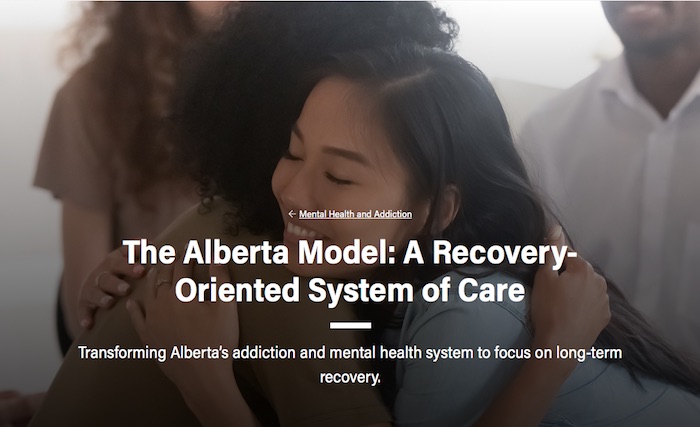Alberta
Province commits $4 million for overdose response teams and 35 detox and pre-treatment beds in Calgary

Expanding access to detox and recovery in Calgary
Alberta’s government is investing in detox, recovery and dynamic overdose response services at the Drop-In Centre in Calgary.
Every Albertan struggling with addiction deserves the opportunity to pursue recovery. As part of building a recovery-oriented system of care, Alberta’s government is providing more than $4 million to the Calgary Drop-In Centre to create dynamic overdose response teams and establish 35 medical detox and pre-treatment beds, capable of supporting up to 1,000 Calgarians every year.
This partnership stems from the efforts led by the Calgary Public Safety and Community Response Task Force to improve public safety while treating addiction and mental health as healthcare issues.
“We’re continuing to treat mental health and addiction as health-care issues by building recovery-oriented systems of care to ensure every Albertan has the opportunity to pursue recovery. Whether it’s rapidly responding to an overdose, accessing medical detox or pre-treatment, the impact of this funding will be life-saving and life-changing for so many Albertans.”
“Our government’s focus on addiction recovery and supports for those facing homelessness is bringing positive change for Calgary. The Calgary Drop-In Centre does incredible work to provide services for many individuals facing homelessness. With more access to addiction recovery treatment, more Albertans will be able to get the help they need to overcome their challenges.”
With this funding, the Calgary Drop-In Centre will significantly increase its treatment capacity. This includes:
- 15 medical detox beds and 20 pre-treatment beds: Albertans struggling with addiction will be supported to safely withdraw from drugs or alcohol under medical supervision. They will also be provided with pre-treatment support to prevent relapse and better understand treatment options as they continue their pursuit of recovery.
- Dynamic overdose response teams: To keep communities safe while treating addiction as a health-care issue, the Calgary Drop-In Centre will work in conjunction with local paramedics, first responders and community organizations to respond to overdoses both at the Drop-In Centre as well as in the community.
“People struggling with mental health and addiction deserve compassion and support, and at the Drop-In Centre they receive both. We’re pleased to work with Alberta’s government to deliver critical services to those in need and help more vulnerable people in our communities pursue recovery from addiction.”
These additional medical detox and pre-treatment beds, capable of supporting up to 1,000 Calgarians every year, will be life-saving and life-changing for countless people in the years to come. All publicly funded detox, treatment and recovery spaces are free for Albertans, with no user fees.
Alberta’s government is continuing to build a recovery-oriented system of care, where everyone struggling with addiction and mental health challenges is supported in their pursuit of recovery. This includes initiatives like eliminating fees for residential addiction treatment, launching the Digital Overdose Response System (DORS) app and expanding access to opioid agonist treatment.
In December 2022, Alberta’s government established two new cabinet task forces to bring community partners together to address the issues of addiction, homelessness and public safety in Calgary and Edmonton. The two Public Safety and Community Response Task Forces are responsible for implementing $187 million in provincial funding to further build out a recovery-oriented system of addiction and mental health care. The initiatives being implemented are part of a fair, firm and compassionate approach to keeping communities safe while treating addiction and mental health as health-care issues.
Quick facts
- Alberta’s government is providing $3.8 million per year, with $1.6 million for dynamic overdose response services and nearly $2.2 million to offer 15 detox and 20 pre-treatment beds, capable of supporting up to 1,000 Calgarians annually. There was also a one-time investment of about $450,000 for capital improvements.
- Clients with opioid addiction will also be able to immediately start on evidence-based opioid treatment medications like suboxone and sublocade through Alberta’s Virtual Opioid Dependency Program.
- Alberta spends more than $1 billion annually on addiction and mental health care and supports, including prevention, intervention, treatment and recovery.
- Any Albertan struggling with addiction can contact 211 Alberta to connect with local services and virtual supports. 211 is free, confidential and available 24-7.
- The Virtual Opioid Dependency Program provides same-day access to addiction medicine physicians and life-saving medications to Albertans across the province. Albertans can call 1-844-383-7688 seven days a week, from 8 a.m. to 8 p.m. daily.
Alberta
Low oil prices could have big consequences for Alberta’s finances

From the Fraser Institute
By Tegan Hill
Amid the tariff war, the price of West Texas Intermediate oil—a common benchmark—recently dropped below US$60 per barrel. Given every $1 drop in oil prices is an estimated $750 million hit to provincial revenues, if oil prices remain low for long, there could be big implications for Alberta’s budget.
The Smith government already projects a $5.2 billion budget deficit in 2025/26 with continued deficits over the following two years. This year’s deficit is based on oil prices averaging US$68.00 per barrel. While the budget does include a $4 billion “contingency” for unforeseen events, given the economic and fiscal impact of Trump’s tariffs, it could quickly be eaten up.
Budget deficits come with costs for Albertans, who will already pay a projected $600 each in provincial government debt interest in 2025/26. That’s money that could have gone towards health care and education, or even tax relief.
Unfortunately, this is all part of the resource revenue rollercoaster that’s are all too familiar to Albertans.
Resource revenue (including oil and gas royalties) is inherently volatile. In the last 10 years alone, it has been as high as $25.2 billion in 2022/23 and as low as $2.8 billion in 2015/16. The provincial government typically enjoys budget surpluses—and increases government spending—when oil prices and resource revenue is relatively high, but is thrown into deficits when resource revenues inevitably fall.
Fortunately, the Smith government can mitigate this volatility.
The key is limiting the level of resource revenue included in the budget to a set stable amount. Any resource revenue above that stable amount is automatically saved in a rainy-day fund to be withdrawn to maintain that stable amount in the budget during years of relatively low resource revenue. The logic is simple: save during the good times so you can weather the storm during bad times.
Indeed, if the Smith government had created a rainy-day account in 2023, for example, it could have already built up a sizeable fund to help stabilize the budget when resource revenue declines. While the Smith government has deposited some money in the Heritage Fund in recent years, it has not created a dedicated rainy-day account or introduced a similar mechanism to help stabilize provincial finances.
Limiting the amount of resource revenue in the budget, particularly during times of relatively high resource revenue, also tempers demand for higher spending, which is only fiscally sustainable with permanently high resource revenues. In other words, if the government creates a rainy-day account, spending would become more closely align with stable ongoing levels of revenue.
And it’s not too late. To end the boom-bust cycle and finally help stabilize provincial finances, the Smith government should create a rainy-day account.
Alberta
Governments in Alberta should spur homebuilding amid population explosion

From the Fraser Institute
By Tegan Hill and Austin Thompson
In 2024, construction started on 47,827 housing units—the most since 48,336 units in 2007 when population growth was less than half of what it was in 2024.
Alberta has long been viewed as an oasis in Canada’s overheated housing market—a refuge for Canadians priced out of high-cost centres such as Vancouver and Toronto. But the oasis is starting to dry up. House prices and rents in the province have spiked by about one-third since the start of the pandemic. According to a recent Maru poll, more than 70 per cent of Calgarians and Edmontonians doubt they will ever be able to afford a home in their city. Which raises the question: how much longer can this go on?
Alberta’s housing affordability problem reflects a simple reality—not enough homes have been built to accommodate the province’s growing population. The result? More Albertans competing for the same homes and rental units, pushing prices higher.
Population growth has always been volatile in Alberta, but the recent surge, fuelled by record levels of immigration, is unprecedented. Alberta has set new population growth records every year since 2022, culminating in the largest-ever increase of 186,704 new residents in 2024—nearly 70 per cent more than the largest pre-pandemic increase in 2013.
Homebuilding has increased, but not enough to keep pace with the rise in population. In 2024, construction started on 47,827 housing units—the most since 48,336 units in 2007 when population growth was less than half of what it was in 2024.
Moreover, from 1972 to 2019, Alberta added 2.1 new residents (on average) for every housing unit started compared to 3.9 new residents for every housing unit started in 2024. Put differently, today nearly twice as many new residents are potentially competing for each new home compared to historical norms.
While Alberta attracts more Canadians from other provinces than any other province, federal immigration and residency policies drive Alberta’s population growth. So while the provincial government has little control over its population growth, provincial and municipal governments can affect the pace of homebuilding.
For example, recent provincial amendments to the city charters in Calgary and Edmonton have helped standardize building codes, which should minimize cost and complexity for builders who operate across different jurisdictions. Municipal zoning reforms in Calgary, Edmonton and Red Deer have made it easier to build higher-density housing, and Lethbridge and Medicine Hat may soon follow suit. These changes should make it easier and faster to build homes, helping Alberta maintain some of the least restrictive building rules and quickest approval timelines in Canada.
There is, however, room for improvement. Policymakers at both the provincial and municipal level should streamline rules for building, reduce regulatory uncertainty and development costs, and shorten timelines for permit approvals. Calgary, for instance, imposes fees on developers to fund a wide array of public infrastructure—including roads, sewers, libraries, even buses—while Edmonton currently only imposes fees to fund the construction of new firehalls.
It’s difficult to say how long Alberta’s housing affordability woes will endure, but the situation is unlikely to improve unless homebuilding increases, spurred by government policies that facilitate more development.
-

 2025 Federal Election4 hours ago
2025 Federal Election4 hours agoHow Canada’s Mainstream Media Lost the Public Trust
-

 2025 Federal Election7 hours ago
2025 Federal Election7 hours agoOttawa Confirms China interfering with 2025 federal election: Beijing Seeks to Block Joe Tay’s Election
-

 John Stossel3 hours ago
John Stossel3 hours agoClimate Change Myths Part 2: Wildfires, Drought, Rising Sea Level, and Coral Reefs
-

 2025 Federal Election6 hours ago
2025 Federal Election6 hours agoReal Homes vs. Modular Shoeboxes: The Housing Battle Between Poilievre and Carney
-

 COVID-195 hours ago
COVID-195 hours agoNearly Half of “COVID-19 Deaths” Were Not Due to COVID-19 – Scientific Reports Journal
-

 2025 Federal Election2 days ago
2025 Federal Election2 days agoPolls say Canadians will give Trump what he wants, a Carney victory.
-

 2025 Federal Election2 days ago
2025 Federal Election2 days agoPoilievre’s Conservatives promise to repeal policy allowing male criminals in female jails
-

 2025 Federal Election2 days ago
2025 Federal Election2 days agoCarney Liberals pledge to follow ‘gender-based goals analysis’ in all government policy





